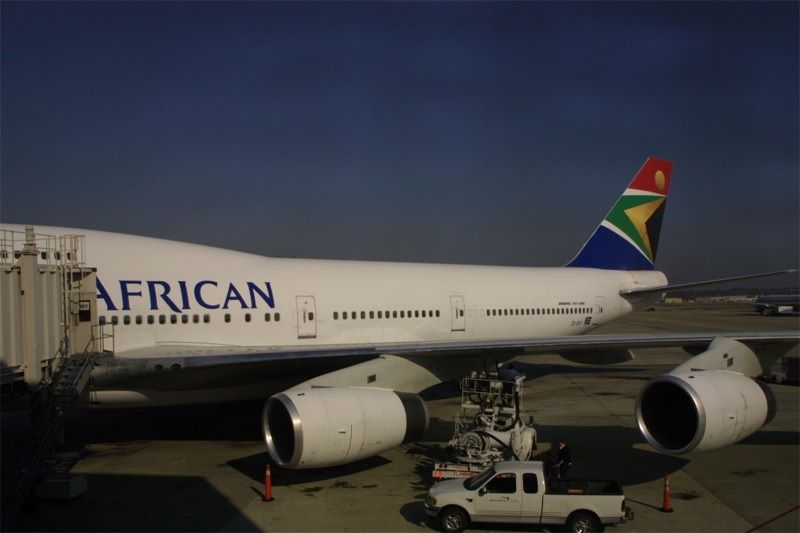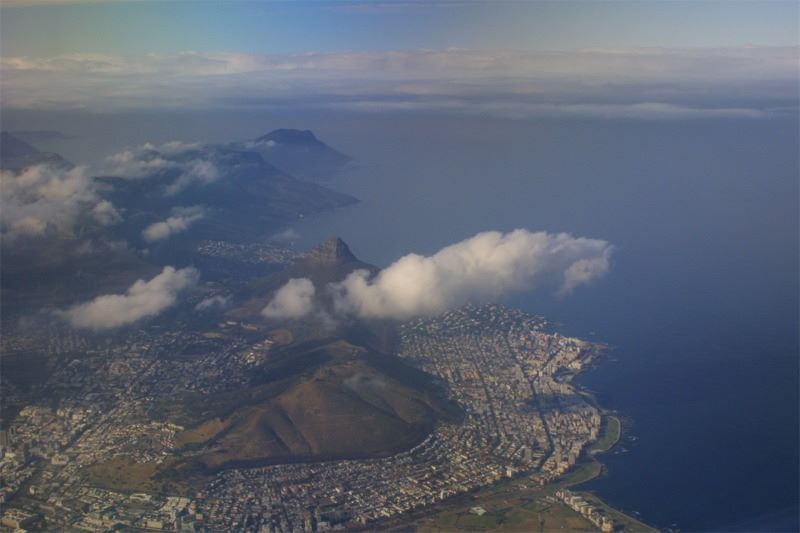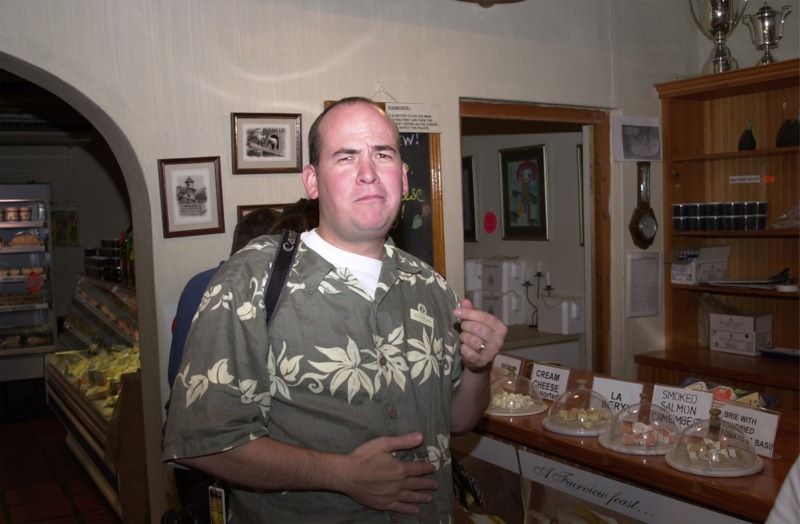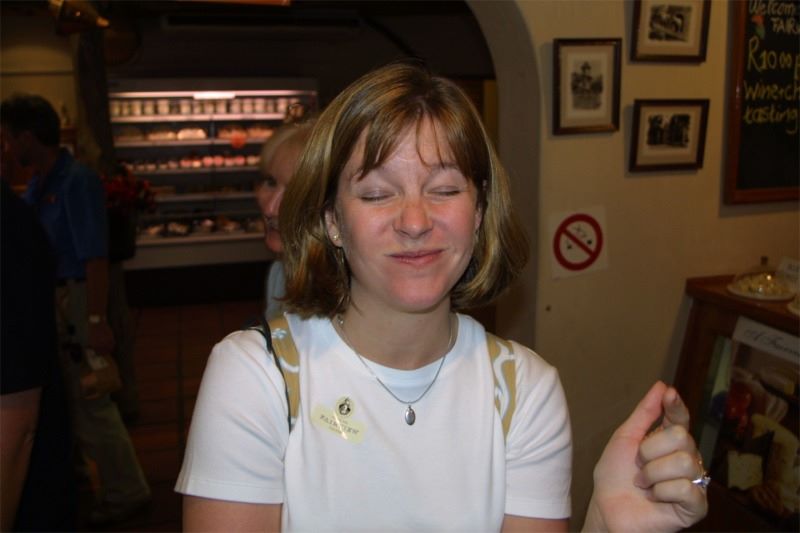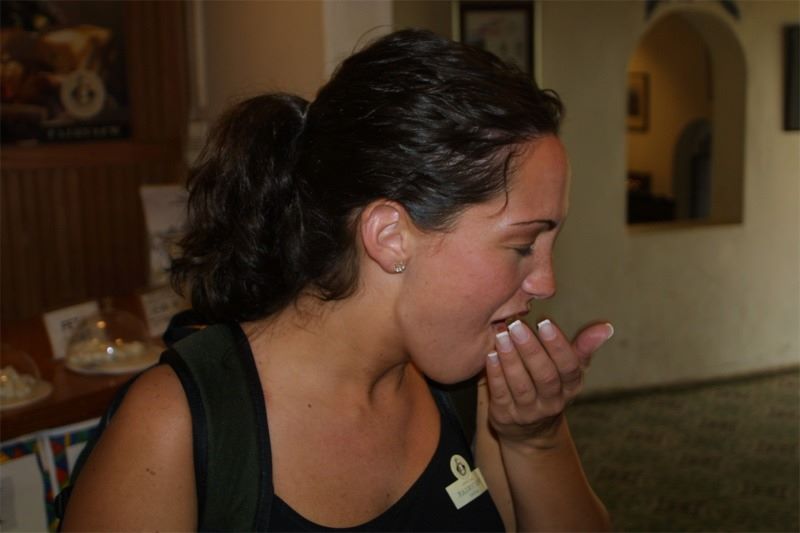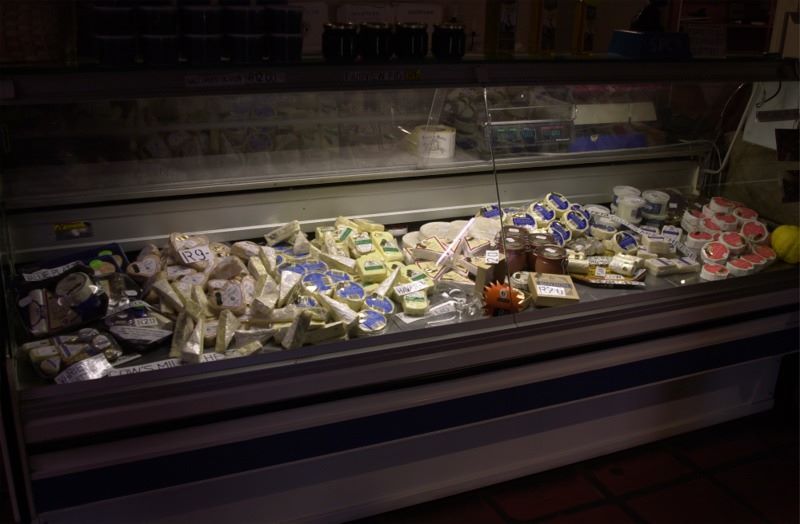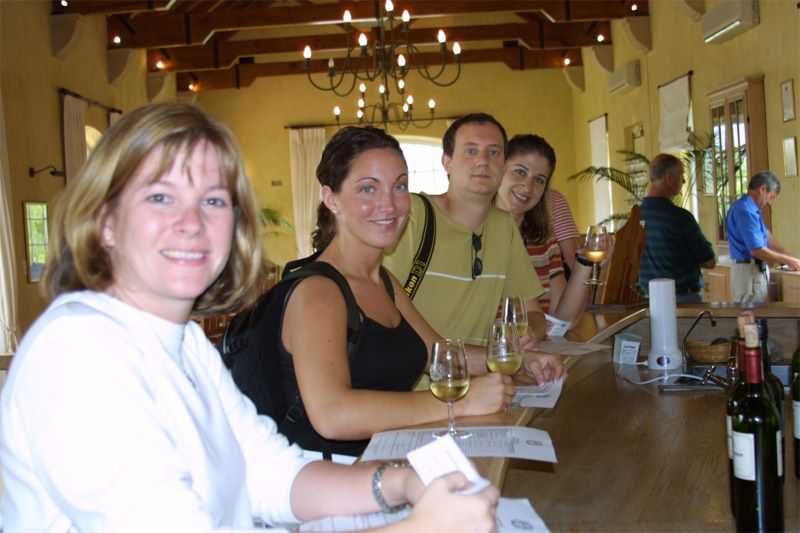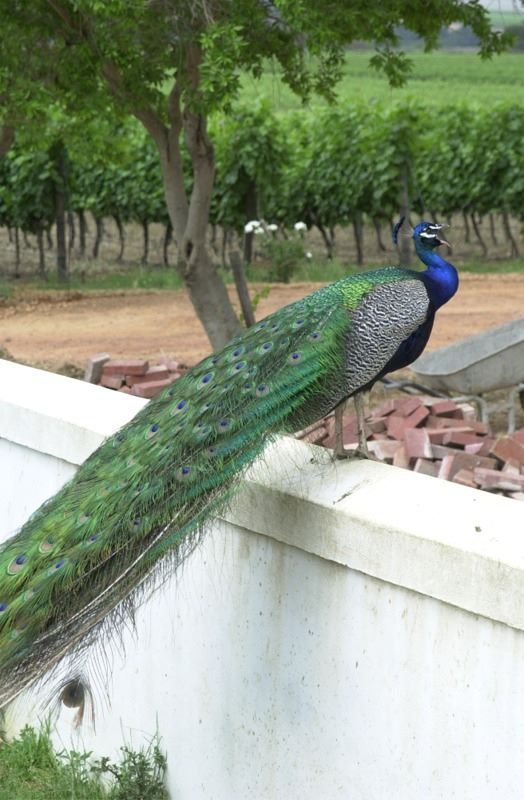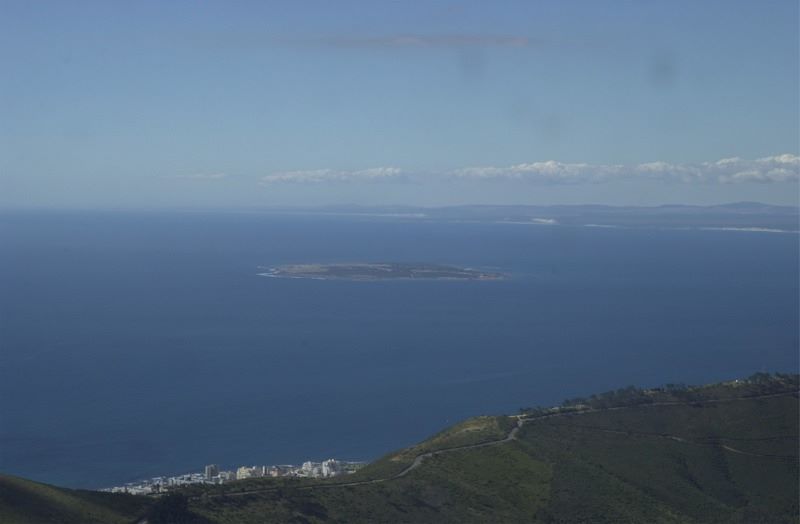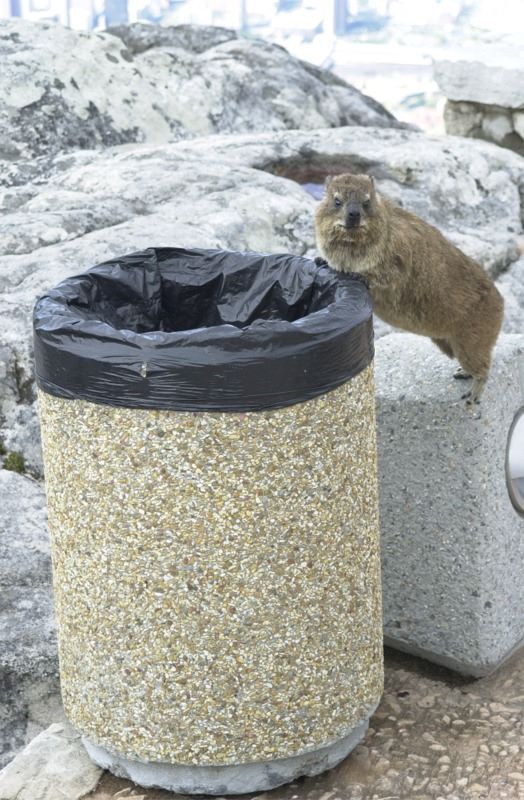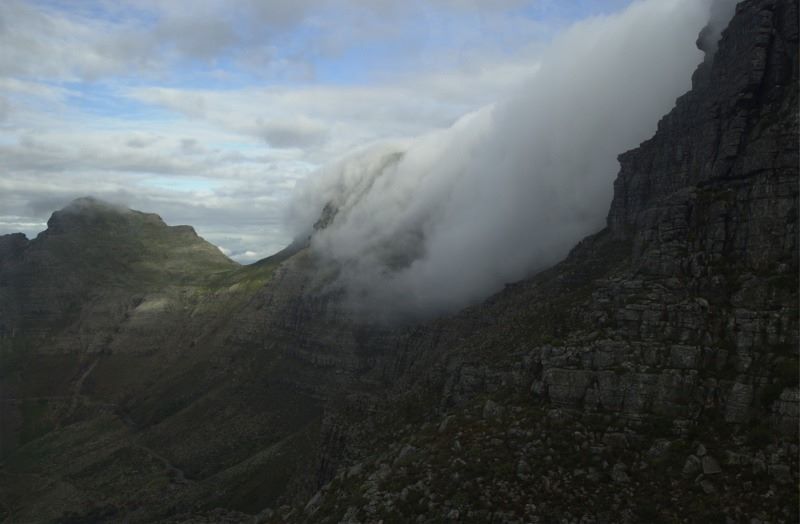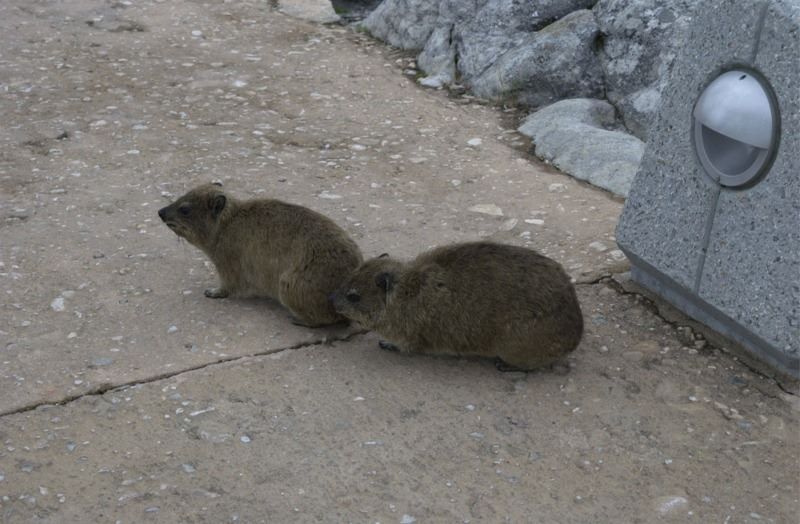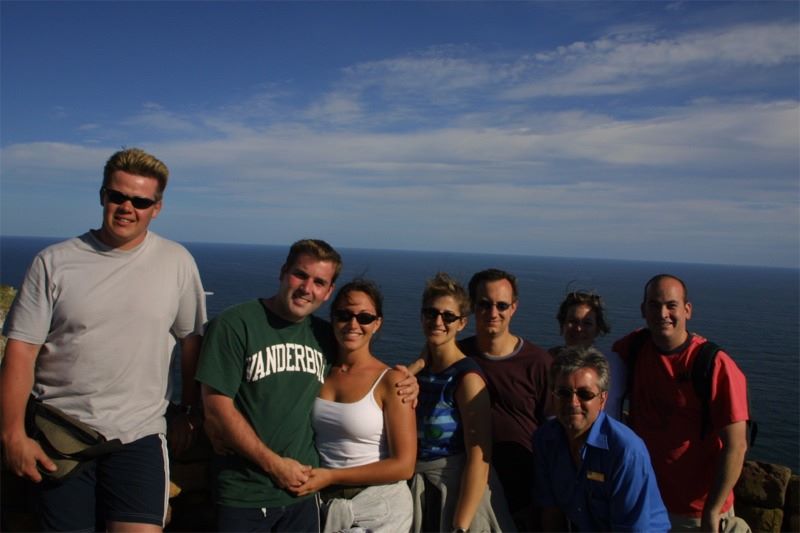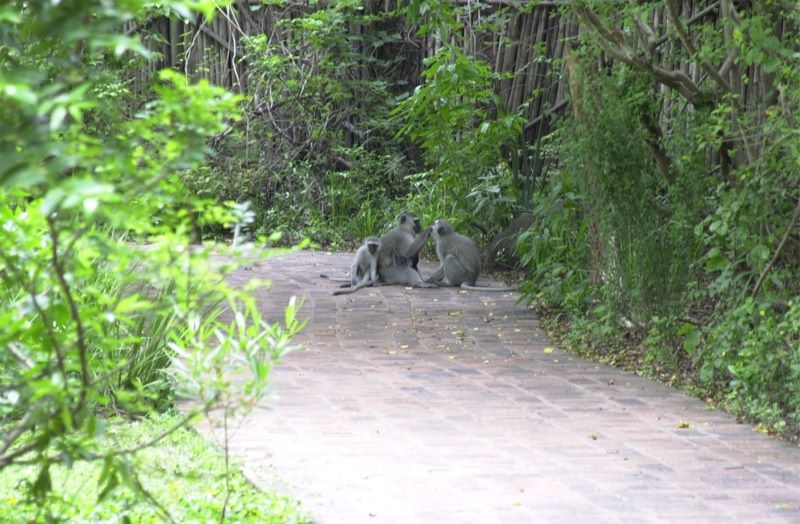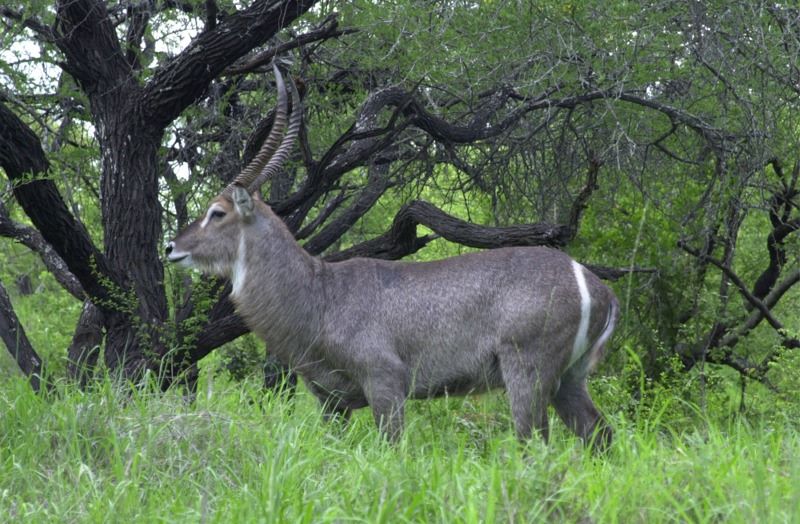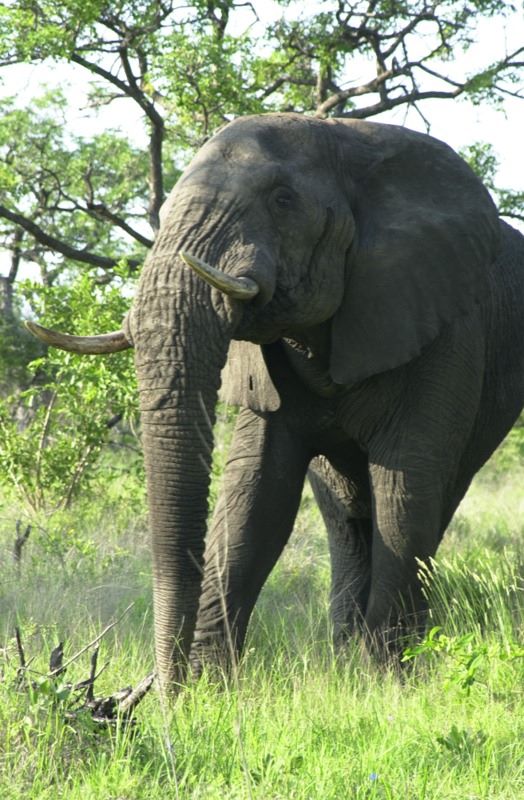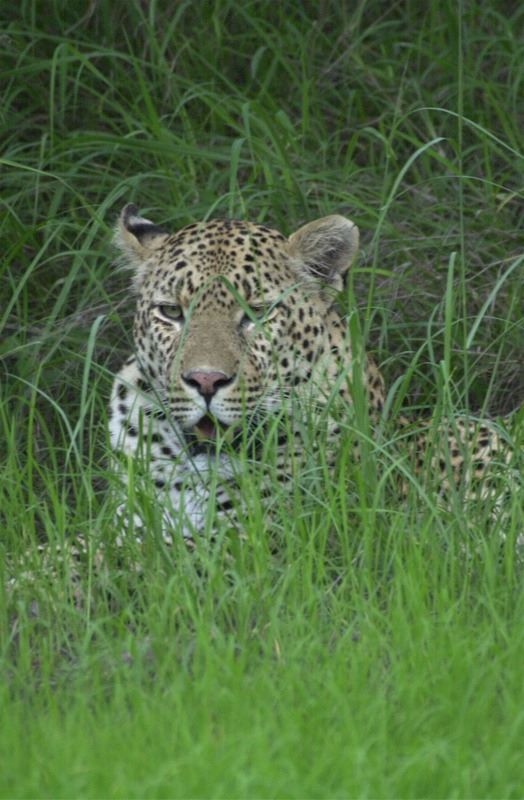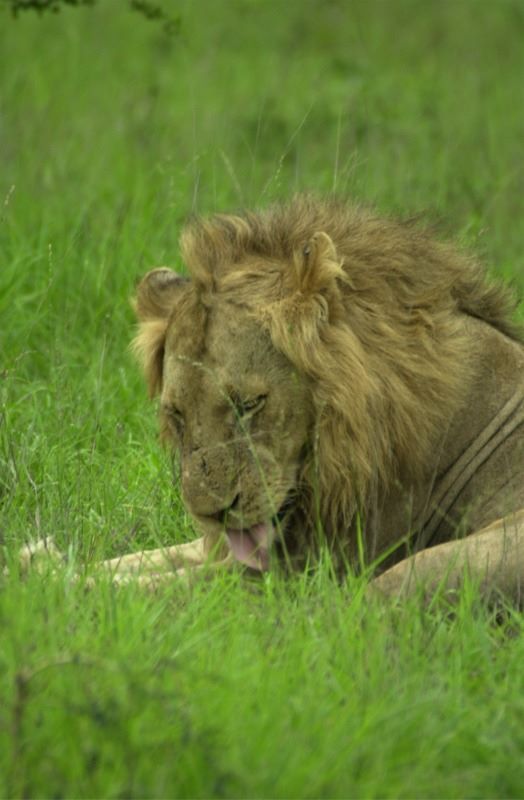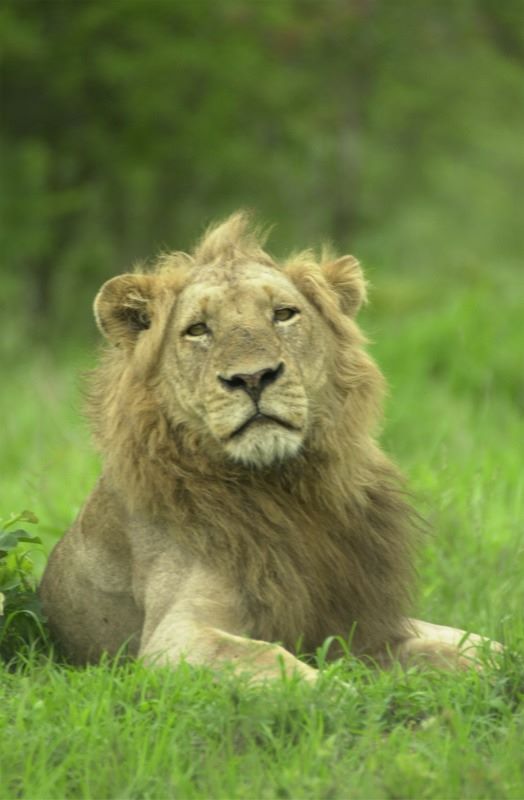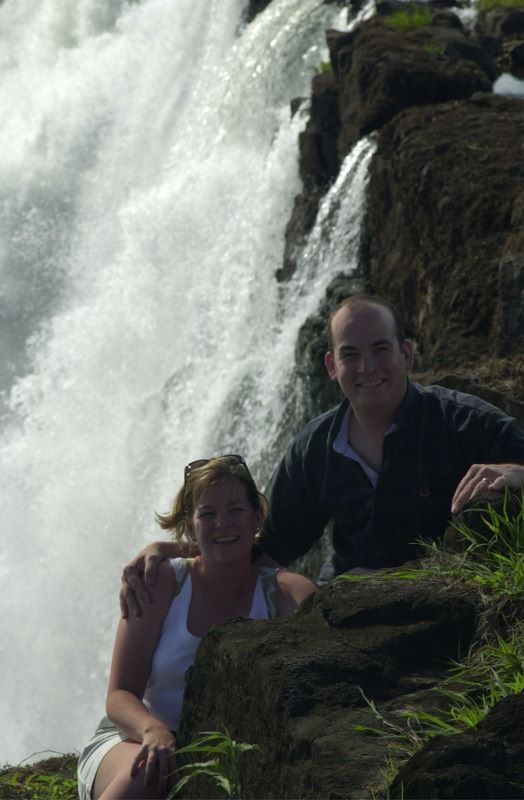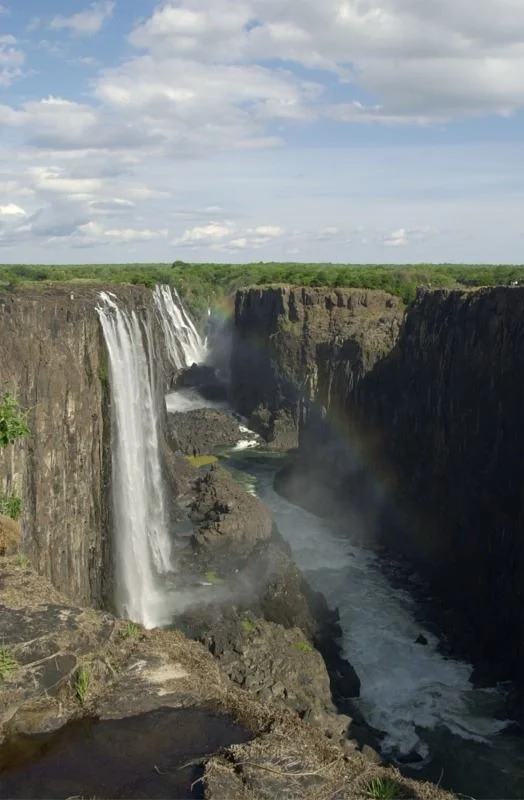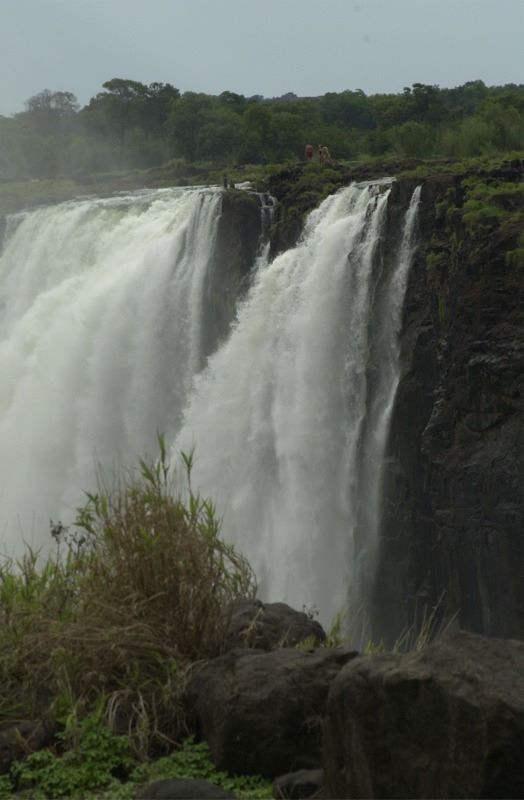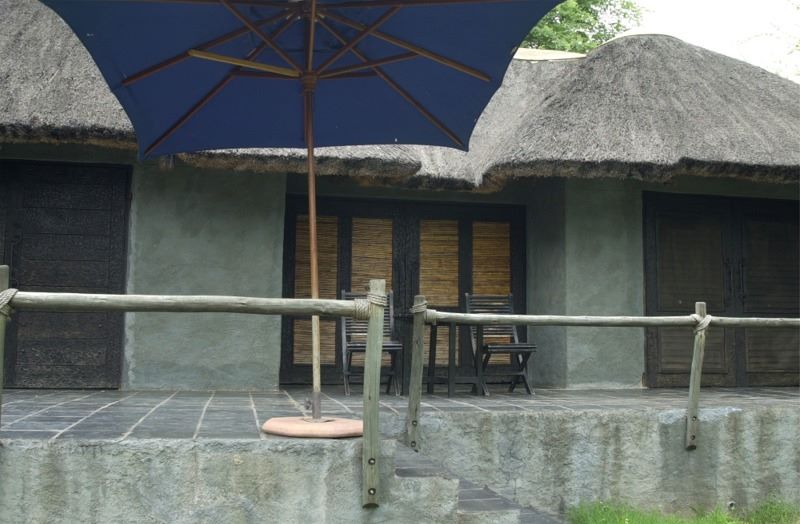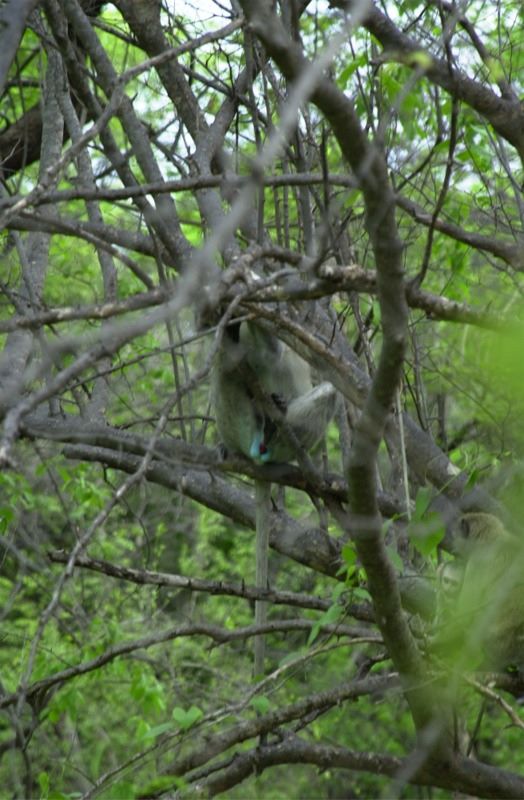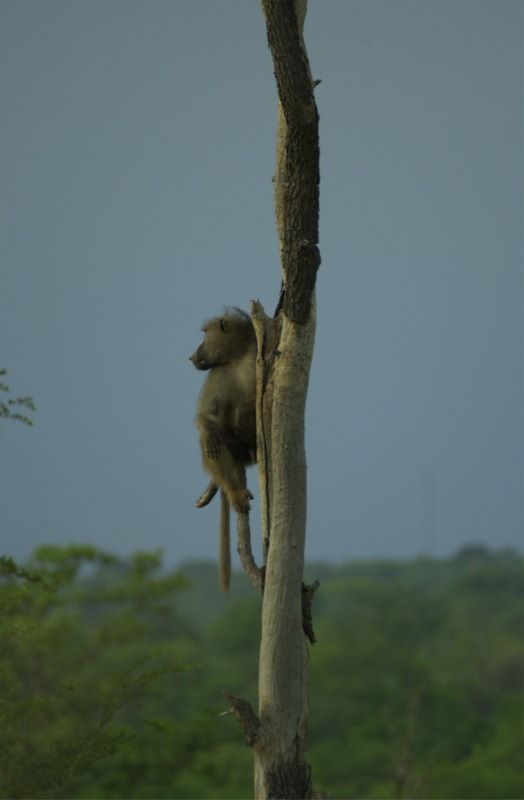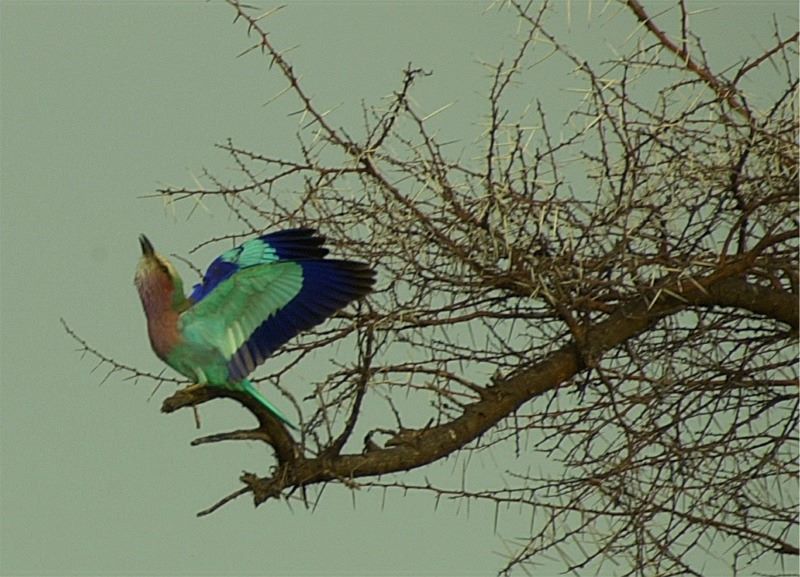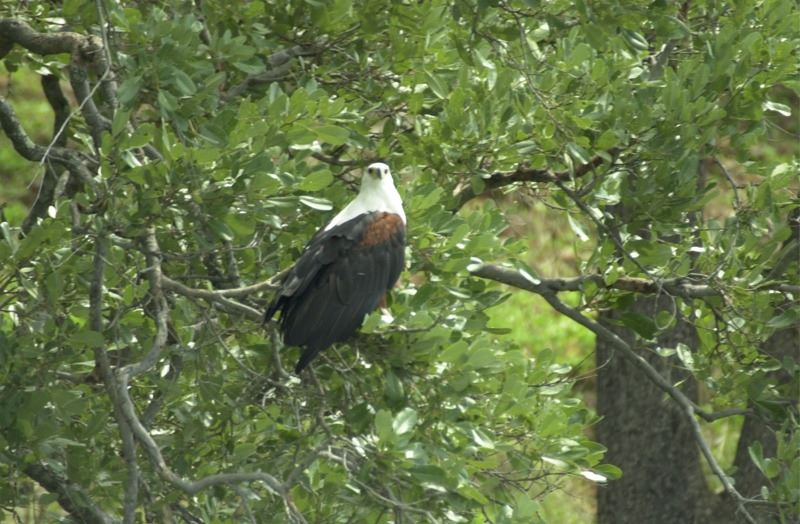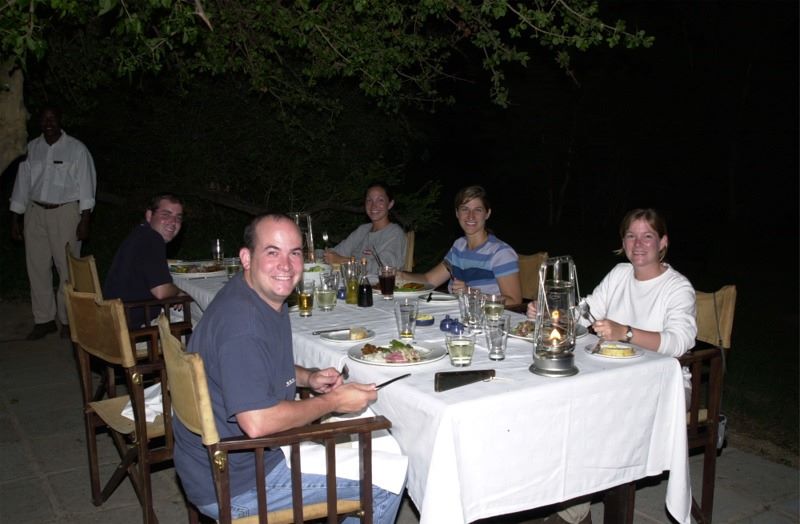Who Needs Turkey?
We certainly don’t, so we packed up and headed for Africa over Thanksgiving. South Africa, that is. Zimbabwe and Zambia too. Why? Why not? Our fine friend Russ has two doting parents who live in Johannesburg, and when they offered to help us set up a vacation to Africa, we couldn’t resist. What kind of preparation does it take to find your self in Cape Town in November? Well, it turns out that it takes quite a few shots (twelve in all), and a very tough bum, as the flight is some fifteen hours long. You also get to take malaria medication all the time you are there, which has, and does, cause vivid dreams and occasional hallucinations. Still up for it? Then pop some pills and stick a few needles in your arms and let’s get going!
Arrival at Cape Town
We arrived at Cape Town at about 8:00 in the morning. Our bodyguard, Fleis, was there to meet us. Having a body guard is a strange feeling. You feel like some sort of VIP, which is doubly funny because we hadn’t showered in two days and we all had chocolate on our shirts from the Snickers ice cream bars we ate on the plane.
Our tour guide hadn’t arrived yet, which gave us a perfect opportunity to sample some of the local drinks. Bloody Mary’s for all! After a few drinks and a quick stop to the Voda shop where Todd and I swapped out our cellular SIM chips for the local South African variety (the US is sooo far behind here), our tour guide appeared and escorted us to Lansarac, which is a winery deep in the heart of Stellenbosh, part of the South African wine country.
The Wine Country
The South African wine country looks a lot like Napa, except that it doesn’t cost an arm and a leg to sample the wine. In fact, South Africa is an American paradise right now due to the 10:1 exchange rate. We took full advantage of this at the wineries. When we arrived at Lansarac our rooms weren’t quite ready, so they provided drinks and let us lounge by the pool. Wow, after a fifteen hour flight nothing feels so good. When the rooms were ready we took quick showers and went off to our first winery: Spier.
Spier is an interesting winery because, right before you enter, there is a place you can go to pet cheetahs. Remember, we had both Danna and Katie in the car, and their attraction to small fuzzy critters cannot be repelled for any amount of wine. So, we took a detour and had our way with the cheetahs for a bit. Danna nearly ripped through the enclosure to get at them. It turns out that cheetahs are, well, cats. They like to be scratched, and they purr. Loudly. You just need to remember to stay away from the sharp parts. When finished we went on to Spier, drank six wines each, and returned home for a wonderful dinner.
Day two found us at J.C. LaRoux, who specializes in champagne. They use the original French technique, “Cap Classique” which involves fermenting the champagne in the bottle. To remove the sediment they slowly rotate the bottle over a period of weeks, until it is upside down and the sediment has all collected in the neck. Then they freeze only the neck, open the bottle, and let the frozen sediment shoot out. Then they top up the bottle and re-cork. It’s a simple technique but it is very time consuming. It does make some tasty champagne, though. But, we’re not really champagne fans, so we headed off to Morganhof, in honor of our friend Russ Morgan.
Morganhof had some very cool grounds, including an underground aging cellar that had a skylight in a flower bed above. Also, they had many large bottles of wine, including a 27 liter Sovereign size that both Russ and Todd bonded with immediately.
While Morganhof was fine and dandy, it wasn’t the highlight. No, the highlight of the day belongs to Fairview winery. Their wine was a little nondescript, but, but, they offered free cheese tastings. Free Cheese! Todd was in paradise, sampling cheese with both hands. Paradise, that is, until he sampled La Beryl. La Beryl can best be described as a cross between toe jam and ass in both aroma and taste. Right before popping it in his mouth he resolutely stated that he never met a cheese he didn’t like. There’s always a first time, though. Naturally, we all had to try it. Naturally, we all had to get our picture taken while trying it. Luckily for us La Beryl was the only cheese we didn’t like. All this cheese eating made us hungry, so we bought a pound of various favorites and some wine and headed off to have a little picnic.
On the way we stopped by a market where Danna and Katie bought some bread. Unfortunately they can’t read Afrikaans, nor are either of them particularly “cooking enlightened”, so they bought brown-and-serve bread. Russ came through for us, though, and bought some bread and a wondrous creation called biltong. Biltong is probably one of the most popular snacks in South Africa. It’s everywhere: vending machines, hotel lobbies, gas stations and grocery stores. In fact, you can buy it in bulk at the casino in Johannesburg. But, I’m getting ahead of myself. Just what is biltong? Why, it’s beef jerky, pure and simple. I love beef jerky. As a result, I also love biltong. (And, apparently so does someone at Microsoft, because biltong is in Word’s spell checker. Go figure).
Meal in hand, all we needed was a place to snack. We saw a grassy area close to the grocery store and went for it. It turned out to be the Huguenot Memorial, but the man at the gate assured us we could snack there. We found a nice secluded area of lawn and started some serious snacking. Whups. The place we decided to sit down was directly between the memorial and something called a “viewpoint”. Several groups of tourists were not terribly happy that our smiling cheese-messed faces were now in their photographs. Screw ‘em – the cheese and wine were great, and, being Americans, we’re used to spoiling the party.
For dinner Fleis took us to a traditional South African restaurant called Volkskombuis, which means “The People’s Kitchen”. They served Ox Tail, Bobodie and Chicken Pot Pie. All of it was excellent, but my favorite was the Bobodie. This is a mince-meat type of pie with a cinnamon-nutmeg flavor to it. On the way home Fleis demonstrated one of his many talents. Our driver had overcharged us by some R170.00 because he had to wait half an hour for us. This was over three times the agreed to rate. We gave the driver our money and went to the bar. Fleis showed up a few minutes later, and gave us all our cash back. He had a little “talk” with the driver. Of course, we bought Fleis several rounds of drinks, blowing the R170.00 anyway, but in a much more enjoyable way.
Cape Town
It wasn’t clear whether we had enough of the wine country or the wine country had enough of us. What was clear, however, was that it was time to leave. So we packed up and headed to Cape Town for a little fun. Cape Town is a wonderful coastal city, and we were staying at the equally wonderful Sea Castle hotel in the presidential suite. We had our own private pool and deck that overlooked the bay. Directly in front of us some construction project was going on, which provided a lot of entertainment as we sat and drank beer (Castel beer, that is, because that’s whateveryone drinks in South Africa). One interesting thing to note about the construction: there was a serious lack of equipment. Lots of people working very hard, but not very many bulldozers, tape measures, levels or other things that would imply precision in the finished result. Mental note: don’t buy property in Cape Town. For dinner we went to a restaurant called Blues and had some fantastic seafood. And wine. Lots of wine. The next morning we were going to find out what hell feels like.
The boat was docked, and it looked innocent enough: A rubber craft with a fiberglass hull. Should have looked at the engines. Two two hundred horsepower engines were strapped to the back of the contraption. The speedboat, designed for quick fifteen minute adventure rides, was about to catapult us for the next hour to Seal Island. This boat is fast. Damn fast. It can go 60 MPH on the open ocean and will come completely out of the water if the driver isn’t careful. But, this is Africa, and the drivers here are never terribly careful. Each time the boat comes out of the water there is the short feeling of weightlessness, followed by a resounding slap as the boat smacks back into the water. It’s fun – if you’re ready for the impact. If you’re not, your butt will slam into the seat and send the entire force of the impact up your spine. After a few such lapses of concentration I was sure I would never walk again.
As we arrived at Seal Island our captain cleverly kept us downwind, in order to heighten the experience. Seals smell. They smell worse than your brother, your sister, and your dear old grandma. They smell worse than truckstop bathrooms. We watched the seals for a while, and got quite close to the island. A few times I was sure we were going to run aground, but we never did.
That evening we dined at one of the best restaurants in Cape Town: Vilamore. Vilamore specializes in serving Langostine, which is a cross between a large prawn and a lobster. It is very tasty meat. The entire experience was fabulous, including a wonderful wine from Mierlust that we would never be able to afford in the states.
The next day we visited Robben Island. This is an Alcatraz-like prison where political prisoners like Nelson Mandela were kept during Apartheid. The tour beats Alcatraz for coolness because the guides were inmates themselves and have a unique perspective. Some of the atrocities that went on there were pretty hard to swallow, but it gave me a real respect for how far South Africa has come in only a decade.
Nelson Mandela's cell
Robben Island also gave me a new respect for gravity: shortly after the boat landed I tripped on a rock and went down. Camera in one hand and back pack in the other, neither of which I was willing to sacrifice, I came down like an old man and rolled on the ground. For the rest of the tour I had a nice blood-drippy knee thanks to the really sharp rocks.
That afternoon we took off on a small jet bound for Johannesburg. No surprises, save for the zero-G I experienced during the turbulent flight. Danna experienced this with multiple senses: first the zero-G and a second time when her drink came back down and landed in her lap. When we landed in Johannesburg all the occupants of the plane applauded. This is a ritual that happened on every flight we took in South Africa, and it does not make you feel very safe. Russ parents’ Scott and Nancy met us at the airport, and we made for their house. That night we would be dining at the wonderful restaurant Carnivore.
Carnivore
Carnivore is not a place for vegetarians. It is not a place for folks who like “side dishes”. Carnivore is a place of meat. Game meat, that is, and when you walk in the front door you are treated to quite a spectacle. The restaurant is centered around a large open fire pit. The pit itself is probably twenty feet in diameter. Large skewers of meat are piled ten feet high above the pit. At your table, you need only raise a small flag to begin the feeding process. While the flag is up, waiters will come with a skewer in one hand, and a machete in the other. The skewer lands on your plate, they tell you what kind of meat it is, and you either nod or shake your head. Should you nod, the machete comes down fast and a hunk of meet lands (hopefully) on your plate. Warning: keep your arms at your sides. Then the waiter moves on, only to be replaced by another, carrying a different kind of meat. They all go in a circle, at a dizzy pace, hacking off hunks of meat. It’s all very primal, and even if you don’t like to eat a lot of meat you will find yourself caught up in the excitement, shouting “more!” “more!” as more and more animals fall to the knife. We ate a lot: élan, kudu, giraffe, ostrich, gembok, stembok. They just kept coming, until we awoke from our meat-induced trance and remembered to lower the flag, signaling our defeat.
After eating so many animals, we were ready to see some that were still living. It’s safari time!
Londolozi
To get to Londolozi one must first fly into Skukuza. Skukuza is a small air strip in the middle of nowhere, and you must take a small two engine turbo prop plane to get there. Once in Skukuza, you board an even smaller, single engine place that will take you to Londolozi. Londolozi itself is simply amazing. Our rooms overlooked the African landscape and we can watch wildlife from our own private pool. We stayed in a thatched hut. A thatched hut with air conditioning, that is. Oh, did I mention that all the drinks are free? After a bit of drinking and relaxing we ventured out on our first safari. But, not without loading up with bug spray.
Our deck with private hot tub and view.
The bug spray is pretty amazing stuff. It keeps off the bugs. It is also very useful in removing fingernail polish, glue, and for eating through watch bands. This offers two possibilities to me: either it is a fantastic bug spray with a few nasty side-effects, or a fantastic industrial solvent with the ability to repel bugs. I wasn’t sure I was going to like wearing this stuff all day and all night.
After loading up on the bug spray, we piled into our Land Rover. Amazing things, these land rovers. They’re quiet so they don’t scare the animals, and appear to be able to climb up just about anything. The first animal we saw was an elephant. A bug bull elephant that appeared to be in heat. It had picked up the scent of a female in the area and was determined to walk in her direction – and we were between them. It turns out that an elephant determined to take a particular path is not going to let a small, eight passenger Land Rover get in its way. We moved.
Mr. Horny Elephant was the only animal who misbehaved for the entire safari. We saw lots of wildlife: giraffe, rhino, élan, elephant, lion, cheetah, leopard, cape buffalo, sbringbok and several other varieties of antelope.
Five days in Londolozi and we were ready to fly back to Johannesburg. From there, we headed to Victoria Falls in Zimbabwe.
Zimbabwe
I was impressed with South Africa. The country is well run, peaceful, and pretty safe as long as you stay out of places you don’t belong. Zimbabwe was my first introduction to a slightly less evolved government. Their government is more corrupt, and the country is in the middle of ousting it. But, we were ready, belted into the seats of our 1962 Boeing 747 200, run by Air Zimbabwe and headed for Victoria Falls. The plane got about ¾ of the way down the runway before the pilot slammed on the breaks and brought the plane to a halt. He was unable to pressurize the cabin, so they couldn’t take off. Forty-five minutes and two engineers later, we deplaned and waited in the airport for another three hours. You see, Air Zimbabwe has only four planes. One was undergoing maintenance, and the other three were in service. When one breaks down on the runway, there is no fallback.
We were contemplating returning to Scott and Nancy’s house when a little man from Air Zimbabwe approached us. He said that they do not know what is wrong with the plane so they don’t know when it would fly. But, he did say that there was a plane leaving in twenty minutes to Harare, and after it dropped off passengers in Harare it would continue on to Victoria Falls. “That sounds like a no-brainer”, Russ said. I should tattoo those words on my back.
"We were not prepared for the “truth” that comes forth from the representatives of Air Zimbabwe."
As we came to find out, Air Zimbabwe isn’t actually working to serve their customers. They are working to fill their planes, and get people into the country. Here is a sampling of the wide range of stories they told us:
"If we leave for Harare the plane will continue on to Victoria Falls. You will be in Victoria Falls by 8:00 PM."
Truth
The plane does go to Harare, then picks up passengers and goes back to Johannesburg. In fact, the Victoria Falls airport is not a manned airport and you cannot fly into it after dark, so it would have been impossible to land.
Reason
Air Zimbabwe would rather pay for a hotel in zim dollars than in rand. It’s cheaper, and it gets us into the country. There is a mandatory $20USD entrance fee to get into the country, which offset the cost of the hotel. In fact, we’re still not even sure there was ever a problem with the plane: Russ thinks they staged the breakdown because the plane was nearly empty.
"You will be staying overnight in Harare. We will pick you up at 5:45AM from the hotel so you can be at the airport in time for a 7:15 flight to Victoria Falls."
Truth
They did pick us up at 5:45, but there was no 7:15 flight. There are no scheduled flights from Harare to Victoria Falls at all, in fact.
Reason
Breakfast at the hotel began at 6:00 and Air Zimbabwe did not want to foot the bill. Instead, they bought us a muffin at the airport.
"The 7:15 flight has been delayed until 8:45 because they just got the plane fixed."
Truth
They didn’t fix the plane until 10:00, coincidentally the same time as the standard flights from Johannesburg to Victoria Falls were scheduled. Had we stayed in Johannesburg we would have been in Victoria Falls by noon.
Reason
Air Zimbabwe needed to stall for time because they were arranging charter flights to take us to Victoria Falls. They were negotiating the cheapest rate with various charter companies.
"This list is a marketing list. By putting your name on it you will be given an apology letter from our marketing department."
Truth
The list was a list of people who would be on those charter flights. If you aren’t on the list, you don’t get on the plane.
Reason
They did not have enough seats on the charter planes. They needed 30 seats and only had 24. We were told that they hoped we could “decide amongst ourselves” which six didn’t get to go. When we complained that the idea was ludicrous, they started using the marketing list as a passenger manifest.
We did finally leave in a small turboprop plane. I was relieved that it wasn’t flown by Air Zimbabwe, but alarmed by what I did see. Here is what I saw during the flight:
- The pilot was teaching the co-pilot how to fly.
- The emergency card in front of me had a schematic of the plane, and the plane only had eight seats. I looked around and counted twelve seats: four more had been added.
- It was 90 degrees F by the time we took off. Our overloaded plane skimmed along the surface of the ground for miles before gaining any significant altitude.
- It was cloudy and there was a lot of turbulence in the clouds, so the pilot was maneuvering around the clouds. Good show. But, he was also climbing to avoid them. Up, up and up we went, topping out at almost 14,000 feet. This was not a pressurized plane. If you didn’t breathe carefully you would get light headed. I hoped this wasn’t happening to the pilots.
- We came down very fast. Faster than my sinuses could drain. Both Laney and I had the most excruciating pain in our sinus as we landed until the pressure equalized. It felt like someone stabbing me in the eye with a pencil.
But, land we did, and everyone clapped. We were all quite sheepish too: this is the first time we have been out of the protective field of Fleis, and we royally screwed it up.
Victoria Falls
As soon as we got to Victoria Falls we were whisked off to lunch at Livingstone Island. Good thing, because we hadn’t really eaten for the last twelve hours and we were all famished. Livingstone Island is a small island that is at the top of Victoria Falls. The island is only there for the dry season. During the rest of the year, the island is completely covered by the waterfall. To get there you have to drive into Zambia, and then take a small motorboat to the edge of the falls. The border crossing at Zambia is funny: our driver took in all of our passports and came out with stamps. We never even had to show our faces.
Once in Zambia we boarded a small rowboat and motored out to the island. It’s not a safe feeling to be on a river in a motor boat when you can see the mist of the falls dead ahead. “What happens if the motor breaks down”, Todd asked. “The motor has never broken down” was the response. Such is Africa: there is no such thing as a contingency plan.
The island itself is beautiful. One side of it falls abruptly off the cliff of Victoria Falls. For lunch, the staff had setup a white tent with a nice table. We had a wonderful lunch of smoked salmon, vegetables and meats. And champagne. Lots of it. We went through four bottles of champagne and had quite a buzz by the time lunch was over. Good thing, too, because after lunch it was time to explore the island.
The staff let us wander around the island where we pleased, and we got some pictures of us right on the bleeding edge of the cliff. Safety at its finest. One member of the staff called our attention to a little man standing at the edge of the cliff, and off he jumped! He climbed up again a few minutes later completely unharmed. Want to go swimming our server asked? Well, after four bottles of courage, we couldn’t wait, so we stripped down to our skivvies and jumped in.
To get over to the rocks where the little man was jumping we had to swim across the current. No easy feat after a lot of champagne. But we were very well motivated, for we were swimming only a few yards from the edge of the falls. I also wasn’t too keen to stay in the Zambezi River any longer than I needed to. Who knows what kinds of things are living there.
We got to the rocks safely. The little man was there, and he jumped into the water about ten feet from the edge of the falls. We were shocked, but he surfaced, swam toward us, and told us to come in. Must be safe, right? So, we jumped in. And, it was perfectly safe! Through the millennia the water had eroded a bowl of sorts here, and there was a natural wall that held you and prevented you from going over the falls. The bowl was about 20 feet deep so you could dive. Once we were accustomed to the water and our natural safety net, we wanted to see how close to the falls we could go. We each took turns having our friends hold our legs while we slid over the wall and looked over the falls. Man, that’s a long long way down. We later learned that a man was killed doing that last year when his girlfriend’s grip slipped. Luckily, we were safe: we had two people holding.
Well, not much could top Victoria Falls for excitement, could it? That’s not really true. The next day we woke up and headed over to the Zimbabwe side of the falls so we could do a little white water rafting.
Rafting on the Zambezi
That afternoon we made arrangements to do some river rafting the next morning. This turned out to be a lot harder than we anticipated. In most countries, you don’t bring much foreign cash. If you need local currency, you go to the ATM. Otherwise, you pay with credit cards because they get the best exchange rate. Not so in Zimbabwe. We spent most of our time in Zimbabwe trying to figure out the money thing, and, after talking with Nancy’s maid Mandy who grew up there, we think we finally understand it. The people want President Mugabe out of office. He’s been president for twenty years and has grown very corrupt. They can’t vote him out because he continues to rig the elections. So, they are trying to starve him out by not putting any money in banks. Without any money, the government won’t be able to last. But, the people still need goods and services from outside nations, and for this they need foreign currency. To get foreign funds, they have opened “grey market” currency exchanges. Tourists can exchange currency in these exchanges instead of going to the banks. As an incentive to go to the exchanges, the grey market exchange rate is much higher than the bank rate. While we where there the bank rate was about 50 Zim dollars to one US dollar. But, we could get 300:1 at a grey market exchange. This is great for tourists, but it has an unfortunate side-effect: it causes inflation. Goods are priced in Zim somewhere between the 50:1 government rate and the 300:1 grey market rate. So, if you went through the grey market, things aren’t a bad deal. But, if you go through the banks, Zimbabwe is incredibly expensive. So much so that most reputable places don’t even take credit cards, because those give out the bank rate and it would royally screw travelers. Instead, you must use cash for everything.
Had we known this, we would have been prepared. But, we didn’t, and we came into the country with minimal cash on hand. The rafting trip was 90 USD per person, but, we didn’t have that much. Putting the trip on a credit card would have cost us 500 USD each! Luckily, we worked out a deal with our travel agent, who bought us tickets through his agency using US funds, which we later reimbursed. Our agent is in South Africa, so the exchange rate there is more reasonable. Money Magic, I say, but it worked, and we were ready the next morning.
White water rafting on the Zambezi is a little different than in the states. First of all, we had to sign a wavier. So far, we’ve been able to do things that would be impossible in the States due to safety concerns without so much as a warning. Butnow we have to sign a waiver? We were worried. The waiver mentioned a “strenuous hike” down to the river valley. No problem, we’re all in decent shape. Hell, Todd’s hiked Mt. Rainer and I’d bet he’d carry us down the mountain if we would just dangle a little cheese in front of him. So sign we did.
Our guides loaded us up with a wet suit, life vest, helmet, and paddle. Then they sent us down the mountain. The trail, if you could call it that, was really steep. It was pouring rain too, making things very slippery. There were times when the trail became so steep they had nailed metal ladders into the surrounding trees and rocks so you could climb down. Climbing down a ladder in the rain by walking on the edges of the rungs is no easy feat, especially with both hands full, but we made it. It took us forty-five minutes, and when we got to the bottom our legs were like jelly.
Once at the bottom the fun didn’t stop. We had to board our boats and row through some very thick reeds to get into the river’s current. Twenty minutes of solid rowing, and now our arms were jelly too. Time to go rafting.
A note about the Zambezi: it’s a category six river, and the rapids we took that day where all either category four or five. We walked around one category six rapid – for safety’s sake. As a comparison, the Colorado River is a category four. Our first rapid was a category five and quite a wake-up. We almost flipped the boat. Laney, who had never been rafting before, decided the whole thing was stupid and wanted off. Now. We convinced her to stay (mostly because there is no where to get off), and she eventually had a fantastic time.
We continued on our way, going between category five and four rapids for three hours. I fell out once, but was able to hang onto the boat through the rapid. I learned another interesting rule while rafting on the Zambezi: when you fall out, get back in fast. Why? Because crocodiles swim in the calm water, so you need to be in the raft before the water slows down too much. After three hours of rafting, we had a nice lunch on the valley floor, and then hiked all the way back up to the top, where they had beer and soda waiting for us.
Matetsi
The next day we headed out for Matetsi Game Lodge, for another safari. On the way our driver chatted us up, telling us some really great stories. I think that at one time he may have worked for Air Zimbabwe. “Yeeaas, then the snake hooks his fangs in your nose. Yeeaas, then he slowly pulls you into his mouth, crushing all your bones”.
Matetsi was similar to Londolizi: very nice air-conditioned rooms and friendly staff. But, Matetsi hasn’t been open for as long as Londolozi so the animals are more afraid of the jeeps. This makes some of them harder to find, but, when you do find them, they act a lot more “wild”. Also, Matetsi has very large herds of animals. We sat in the middle of several hundred elephants while they snacked their way across the land.
Like Londolozi, you are not allowed to go out at night alone because of the animals. Unlike Londolozi, there are no phones in the rooms and instead you are given a whistle. Blow the whistle if you are in trouble and someone will come running. On our first night, we had finished dinner and Danna and I were getting ready for bed when we heard a faint scream. “Help!” “Hellllp!” Then nothing. A few minutes later, more screams, more desperate. High on Larium, our dream-inducing Malaria medication, all sorts of things went through our heads. We were without a phone or any way to escape, stuck in the middle of Zimbabwe, a country who has been killing white farmers and taking their land. After about twenty minutes of intermittent screams everything grew silent, and there was the sound of voices outside our room, speaking in Afrikaans. We didn’t get much sleep that night.
The next morning we found out what all the commotion was about. Todd and Katie went out on their deck after coming back from dinner, and Katie closed the door to keep the bugs out. The door locked, leaving them stranded on their deck with their precious safety whistle on the nightstand. They yelled and yelled, but no one came. In the end they walked up the path to the security guard, who was a little surprised to see them.
Safaris at Matetsi were fun. We didn’t see the variety of animals we saw at Londolozi, but we were much more on the edge of our seats. The animals we did see were much more unpredictable. Our tracker at Matetsi was also first rate. He found things that, even after a lot of concentration, we could barely see. My only regret for the safari was that we stiffed them on the tip a little bit. We didn’t mean to; we simply didn’t have any more cash. We gave them everything we had except for the coveted twenty dollar bill we each needed to leave the country. That bill was our ticket home, and it was the most important thing we stored in the safe.
The flight back to Johannesburg went just fine. This time Air Zimbabwe didn’t try any trickery. Why would they? They knew that we were broke. Another day in Johannesburg to relax and then we boarded a flight for New York. The flight had to stop on a small island off the coast of Africa to refuel, it was so long. After arriving in New York, we spent the day there checking out Ground Zero, and then flew back to Seattle. Ironically, we never lost a piece of luggage until the New York-Seattle flight.
South Africa was a blast – I highly recommend it. As much trouble as we had in Zimbabwe getting stuck in Harare, I would still recommend visiting the country. Victoria Falls is beautiful, and there is a ton to do. Just bring cash, and be patient.

